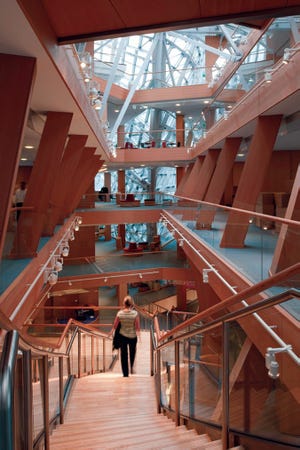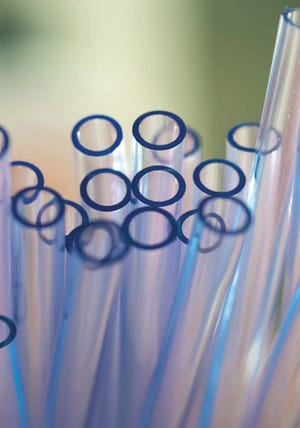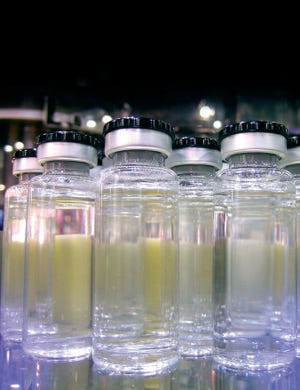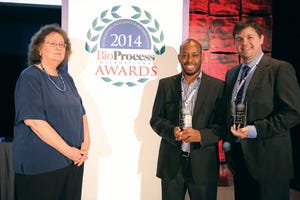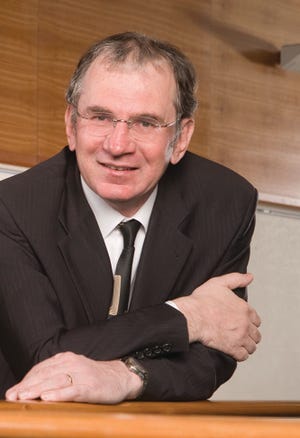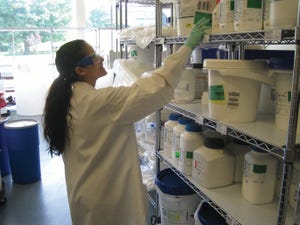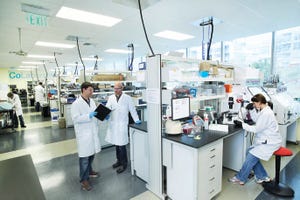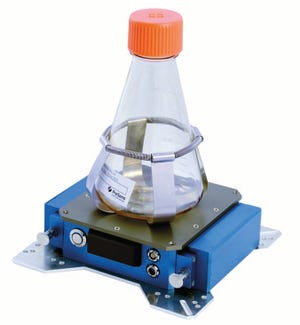Editorial Advisor Retires
BioProcess International
— and the overall industry — will miss retiring editorial advisor Laurie Donahue-Hjelle, formerly associate vice president at Life Technologies, Inc., in Rockville, MD. She earned her BA in biochemistry at the University of CA–Berkeley and a PhD in molecular, cellular, and developmental biology at the University of CO–Boulder. For most of the 1990s, Laurie served on the faculty of Texas Tech University’s Health Sciences Center (department of cell biology and biochemistry), where her laboratory focused on the molecular mechanisms underlying stem-cell differentiation.
In 1997, Laurie left academia for the biotechnology industry, taking subsequent R&D management positions with Cascade Biologics and Sigma-Aldrich. Her teams developed media for primary and stem cell types and were the first to use transcriptomic approaches to develop such media. Laurie joined Life Technologies in 2006, ultimately holding several positions in its bioproduction division: Gibco ...
When asked to envision a modern biotechnology laboratory, lay persons might describe what they’ve seen on an episode of
CSI: Miami.
Gleaming glass and striking colored lights might look good on television, but they are not what biological researchers need to do their work most effectively. Most of the real biological laboratories I’ve visited, in fact, have been stark, white, fluorescent-lit environments that more resemble something out of
2001:
A Space Odyssey
. But those are becoming passé. The newest concepts incorporate natural lighting and expansive interiors to encourage collaboration and creativity. And technologies such as robotic automation and single-use systems are as much of an influence as the needs for cost containment and environmental sustainability.
Technology has always driven laboratory design, of course, from the darkness of 19th-century research before electricity to the fluorescent lighting so familiar to scientists and office workers of the 20th century. Biological research has...
A Chemistry, Manufacturing and Controls (CMC) Strategy Forum titled “Accelerated Product Development: Leveraging Combined Industry and Regulator Knowledge to Bring Products to Patients More Quickly” was held in Washington, DC, on 27 January 2014. Biological therapeutics in development are demonstrating remarkable results in the clinic for many indications. So companies are seeking ways to accelerate the approval of these therapies and rapidly bring them to market.
Many such products take the form of well-characterized proteins (e.g., IgG1 or IgG2 monoclonal antibodies, MAbs) for which both industry and regulators can leverage extensive CMC and clinical experience. The need to reduce the time it takes to get biological medicines to patients for unmet medical needs, rare diseases,
and orphan indications is a real concern. Even novel molecular entities such as antibody-drug conjugates (ADCs), bispecific proteins, and enhanced enzymes could use enhanced regulatory pathways to approval. Regulators have designe...
https://bioprocessintl.com/wp-content/uploads/2014/12/122014_Jain.mp3
www.graphicstock.com
Revenue from operations (herein referred to as
revenue
) and operating cost (herein referred to as
cost
) are two independent sentinels of a corporation’s performance and return on investment (ROI), which is defined as the ratio of revenue to cost (revenue/cost). Although a company can actively manage cost by controlling its number of full-time employees (FTEs) and the number or type of activities, it cannot directly manage revenue. Revenue is entirely driven by market forces. So if a company experiences a decrease in revenue, then cost also must be reduced by the same fraction to maintain ROI. However, none of these three parameters alone (revenue, cost, and ROI) provides information about the operational efficiency of a company. To expand on this point, scenarios for two hypothetical companies (A and B) in the same industry are described below.
Revenue:
Company A generates $1,000 revenue with 10 FTEs (or equipm...
As the bioprocess industry progressively adopts single-use technologies for large-scale manufacturing (
1
,
2
), biomanufacturers’ increased reliance on integrators for critical production equipment continues to raise concerns about supply chain security. The need to mitigate risks associated with the supply of single-use components (e.g., bioreactors, aseptic connectors, tubing, filters) has led to growing interest in the dual sourcing of those materials. To that end, integrators and end users alike are exploring the definition of
functionally equivalent
products, how functional equivalency can be demonstrated, and strategies for managing functionally equivalent parts.
Using platinum-cured silicone tubing as an example, ASI-Life Sciences proposed a way to define functional equivalency and demonstrate functional equivalency of materials from two suppliers, with a third party (Chemic Laboratories) conducting the necessary tests. Our methods includes two options for managing the dual supply of tubing.
R...
https://bioprocessintl.com/wp-content/uploads/2014/12/122014_Langer.mp3
Enthusiasm in the United States over opportunities for biosimilars has waned since such products were first launched in Europe. The hesitation stems from confusion and uncertainty surrounding regulations. Manufacturers and suppliers are looking for guidance from the US Food and Drug Administration (FDA), which has promised guidelines that are still in process after five years. Even naming protocols for biosimilars are clogging the works. And in the absence of coherent FDA guidelines, many US states are haphazardly implementing laws concerning biosimilars. But the stakes are high, so many commercial decision-makers, insurers, and policy strategists continue to waiting for specific guidances from regulatory authorities before they move forward.
JIM DE LILLO (WWW.ISTOCKPHOTO.COM)
The US Senate recently pushed the FDA to release guidance documents on biosimilar drug approvals (
1
). In August, a group of senators wrote the US Department o...
The mission of the
BioProcess International
publication has always been to deliver valuable industry information to the biotechnology community to continue on the path of scientific advancements, revolutionary technological applications, and strategic partnerships and collaborations. We are honored to cover this market and work with the many talented people sharing their expertise and projects. Now is the time for us to recognize and honor the outstanding people, organizations, and technologies that have significantly influenced and advanced the efficiency of biotherapeutic development and manufacturing processes, ultimately allowing the industry to deliver better, more effective treatments to a global patient base.
In January 2014,
BioProcess International
opened nominations to the industry through a secure online site. Nominations remained open through 18 July 2014. Each submitted nomination was transferred to an individual ballot form. We consolidated those ballots by category and electronically se...
Roger-Marc Nicoud received his PhD from the University of Lorraine in process simulation for the nuclear industry. He joined Separex in 1987, first as a technical director and then as a managing director until 1995. Between 1993 and 1995, he also worked as professor and headed a research laboratory involved in thermodynamics at the University of Lorraine.
Roger-Marc Nicoud
Nicoud founded Novasep in 1995 with the objective of developing comprehensive solutions for producing biologic and synthetic molecules. Novasep became a leading life-sciences company with a recognized portfolio of innovative technologies. He worked as CEO of Novasep until October 2012 and as chairman of the company’s supervisory board until February 2014. Nicoud just completed a book titled
Chromatographic Processes: Modeling, Simulation, and Design
(to be published in early 2015), in which he shares his historical passion for science and process simulation.
In November 2014, Nicoud started Ypso-Facto, a service provider helping life-...
When it’s time to move from preclinical to clinical-phase product testing, many biopharmaceutical companies face a difficult decision: whether to build or buy a biomanufacturing facility for in-house production or outsource the work to a contract manufacturing organization (CMO). Accinov is a new company that straddles the line between those concepts. Its new biomanufacturing center supports client companies toward clinical development in an innovative way.
NEXITY (WWW.NEXITY.FR)
We propose a groundbreaking model for running good manufacturing practice (GMP) biomanufacturing. Our company’s approach offers a prequalified GMP environment that includes integrated pharmaceutical support services and pharmaceutical responsibilities. This approach allows drug-sponsor companies to run their own processes and to focus on their own core manufacturing activities in a flexible facility that can take them rapidly from preclinical to clinical phase.
Stakes and Challenges
Over the past three decades, biotechnology has ...
https://bioprocessintl.com/wp-content/uploads/2014/12/122014_Price.mp3
Shire’s process development department recently overhauled its inventory control system. The result was a projected five-year net benefit of over US$1.5 million and an immediate increase in its scientists’ productivity and satisfaction.
Hiding in Plain Sight
We asked one of our scientists why he kept 12 cases of gloves on his laboratory bench. “I use a lot of them,” he told us. “I don’t want to run out.” When asked how long his supply would last, he replied, “I don’t know. But when I get to 11 cases, I’ll reorder.” As a chemical engineer, he develops and scales up bioprocesses for transfer to manufacturing. That was his focus, not his gloves. So he ensured that he always had enough of them.
Understanding and respecting that scientist’s viewpoint gave us insight into how to solve our inventory problem. It was a problem that would be exacerbated when the process development department moved in 2012 from the company’s facility in Cambridg...
Looking at the landscape today, it’s hard to believe that in 2004 the Mission Bay neighborhood of San Francisco, CA, was home to only two biotechnology companies. Over the past decade, industry-leading organizations across academia, clinical care, and research have settled in the area, creating a thriving ecosystem of more than 100 life science companies. Prestigious academic and research institutions such as The Gladstone Institutes and University of California San Francisco as well as life science accelerators such as QB3 are included in this lively biotech cluster.
As the third-largest biotech employer in the Bay Area, Bayer HealthCare recognized early on that establishing a presence in Mission Bay would allow for new synergies and encourage a culture of innovation. With this in mind, the company moved its research headquarters (the US Innovation Center) to Mission Bay in 2011. The goal was to optimize early stages of innovation and forge new early drug discovery alliances by leveraging core capabiliti...
with Dr. Gernot John of PreSens Precision Sensing GmbH
Shake flasks are simple, low-cost devices widely used in screening and media optimization. The most widely measured parameter to determine biomass is optical density (OD). It is typically measured offline because no suitable equipment for broad range biomass measurements in shake flasks has been available. But a new, compact,
SFR vario
device from PreSens Precision Sensing can be placed under shake flasks to measure four parameters online: pH, O
2
saturation, oxygen use rate (OUR), and biomass.
John’s Presentation
Our goal is to make shake-flasks give you more information to improve your process understanding. Oxygen (O
2
) and pH sensing dots are integrated into shake-flasks, and their fluorescent signals are read by our device to determine oxygen and pH online. Integrated into the system’s optics, our biomass sensor measures light scattering. During movement of shake flasks, liquid distribution is uneven and adjusted toward one side of the shake-...
with Francesc Gòdia (chemical engineering professor at the Universitat Autònoma de Barcelona)
Chemically defined media free of animal-derived components are required for bioprocess operations based on mammalian cells. Supplementation of commercial media with specific compounds was studied using a design of experiments (DoE) approach to screen the most efficient compounds for two cell lines and then determine their optimal conditions. DoE allowed simultaneous testing of several compounds to determine potential interactions among them in addition to their individual effects.
Gòdia’s Presentation
Our work in optimization of animal-cell culture is a hybrid approach between using basal media and very complete, chemically defined, and serum-free media. We began with existing commercial media and supplemented them with specific proteins to improve cell growth. Our DoE starts with a proof- of-concept using a mixture of supplements to confirm that these improvements are realistic. Then we followed a two-step DoE a...

